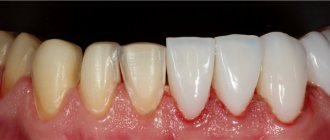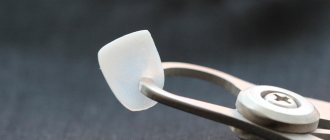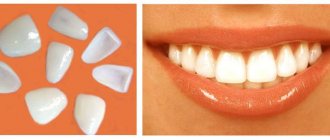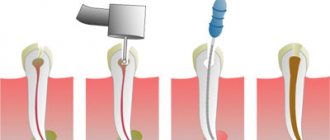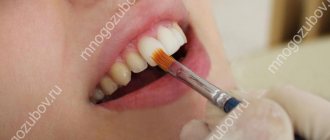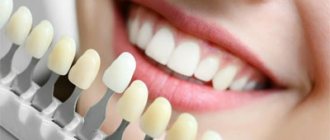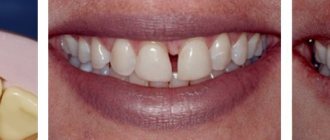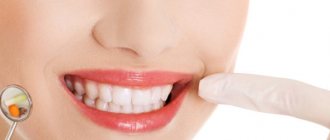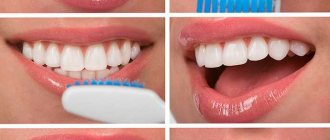It’s easy to become the owner of a snow-white smile these days. All you need to do is use dental services and install veneers. These are thin plates on the front surface of the tooth that maximally imitate the properties and appearance of natural enamel. This smile is designed to bring joy for many years, but sometimes situations arise when the fillings need to be removed. How are veneers removed and what happens to the teeth after that?
Veneers are divided into 2 types: composite and ceramic. Composite veneers are made from the same material as fillings. Ceramic ones are varied in composition. These include glass ceramics, feldspar-based alloys, and polycrystals.
Veneer replacement process
Let's say right away - it doesn't hurt. The entire procedure is performed under local anesthesia, so the patient may experience only mild discomfort. There are 2 ways to remove veneers from teeth.
The first method is classic. They are simply cut down with a diamond bur
. The main thing for the doctor is to stop in time and not damage the thinnest layer of enamel, which is useful for attaching new linings. But in this case it is necessary to completely remove not only the veneer, but also the cement.
The second way is innovative. Plates are removed using a laser beam
. The laser instantly heats the dental cement and it breaks down. This allows you to remove the veneers from your teeth in a matter of seconds.
Composite veneers applied directly cannot be removed with a laser, only with a bur.
Dental treatment with veneers and crowns
Patients often have a question: how to treat teeth under veneers and crowns, because they are covered with artificial material from the front part/on all sides. The answer is simple: there are no difficulties in this. Modern dentistry provides for dental treatment without removing the veneer/crown with complete preservation of the structure. Treatment of a tooth under a veneer/crown is not much different from standard endodontic treatment.
Using a special tool, the doctor drills a small hole in the crown, through which access to living tissue is provided. Modern treatment methods even provide for the possibility of refilling the canals if necessary. At the final stage of treatment, the access in the crown is closed with a filling, the same one that is used to treat teeth without structures. It does not matter what material the crown is made of. Thus, the patient does not incur additional expenses that are inevitable when removing a crown and then reinstalling it.
If the patient has problems with the unit on which the veneer is installed, the treatment is even simpler, since the back of the tooth is not affected and access to living tissue is free.
Replacement steps
After removing the veneers, the surface of the teeth is cleaned of cement residues. If necessary, dental treatment is performed before veneers are replaced. In most cases, additional preparation (enamel removal) is not required. The process of replacing veneers with new ones follows the same algorithm as the initial installation:
- taking an impression;
- color selection;
- installation of temporary overlays;
- production of veneers;
- fixation.
Crowns
A crown is a structure that restores or replaces the crown part of a tooth. Regardless of the material from which the structure is made, the crown covers the tooth completely (front teeth on two sides, chewing teeth on four, including the chewing surface). The main purpose of installing a crown is to treat the tooth and restore its chewing function. Using a crown, teeth that are more than 55% damaged can be restored. At the same time, the crown complements the aesthetics of the appearance. Before installing the restoration material, the tooth is ground down.
Thus, the main differences between veneers and crowns are the installation method and the main functions.
Is it possible to remove veneers without installing new ones?
You cannot leave your teeth unprotected, even if you have such a desire. The prepared tooth is characterized by increased sensitivity. Food and hygiene will cause discomfort. The appearance of the prepared tooth is far from perfect. On the front teeth, this is especially noticeable. The thin layer of remaining enamel is not able to fully protect the tooth, and the risk of developing caries increases significantly.
The main disadvantage of installing veneers is the irreversibility of the process. Having installed veneers once, you will have to do it always. But there are undeniable advantages: veneers give you self-confidence, make your smile attractive and protect your teeth.
The only alternative to veneers is crowns. Unlike onlays, crowns surround the tooth on all sides. In some cases, this is important. For example, if you had to treat deep caries and put in a huge filling. It is undesirable to put a veneer on such a tooth, but a crown is quite possible.
Expert of the article Alekperov Roman Borisovich Dentist-orthopedist, doctor of the first category
Work experience24 years
Another important argument in favor of veneers
The fact that installing veneers makes your smile perfect is obvious - now we are only talking about the ratio of possible risks and benefits.
- Veneers require careful attention to your teeth.
Before the installation itself, it is necessary to treat all foci of caries, even the most insignificant and unnoticeable ones. And after that, maintain hygiene more carefully than before: cleaning with an irrigator and professional hygiene every six months is recommended. This contributes to the preservation of dental health rather than the development of diseases.
- Veneers make you take care of your teeth.
Although caring for them is no different from caring for natural teeth, nevertheless, after such an aesthetic procedure, the motivation to maintain the result increases.
All over the world, veneers (in their modern sense) have been installed for almost 40 years. During this time, sufficient experience has been accumulated: dentists have come to the unanimous opinion that such aesthetic dental restoration is recommended to everyone, unless there are contraindications. Of course, if the procedure was harmful and caused the need for prosthetics in the future, this relationship would have already been discovered. It would be unprofitable to install veneers, because treatment and implantation are expensive. Nevertheless, many clinics offer the service, often with a guarantee of 10 years or more. The main thing is that the veneers are installed with high quality, then there will be no harm or disruption of the function of the teeth.
Other articles:
- Can veneers correct crooked teeth?
- Aesthetic dentistry: how to correct all imperfections
What it is?
A veneer is an overlay with a maximum thickness of 0.5 mm, made of composite material or porcelain. The tooth hidden behind it looks perfect because it masks minor enamel defects.
Overlays first appeared in the 30s of the last century in America. They were invented by C. Pincus. In this way, the dentist helped Hollywood stars achieve the perfect smile. The tooth was covered with an adhesive compound, which attached the veneer for up to 2-3 days. At that time, no one thought about whether it would cause harm, since no preliminary grinding was required. Modern records are strikingly different from the first ones, but still allow you to achieve the desired aesthetic effect in a short time.
Why are veneers so expensive?
The cost of veneers is influenced by many factors. And the most important of them: the price of the material and the manufacturing method. Thus, composite onlays, which are formed directly in the patient’s mouth, cost no more than installing a crown. But the manufacture of ceramic veneers requires high professionalism and a significant investment of time from the dentist and dental technician.
First, an imprint of the tooth is made, then an impression is made, from which the technician will manually sculpt the future plate layer by layer. The process of making veneers is completed by firing in an oven. Thus, the creation of an onlay that is visually indistinguishable from a tooth can only be compared with the birth of jewelry: the work must be so professional and precise. And, of course, it simply cannot be affordable!
Author: Alexander Yaganov Orthodontist. Work experience more than 7 years.
The information is for reference only. Before treatment, consultation with a doctor is necessary.
Causes of complications
When wanting to install veneers, people pursue aesthetic goals. The constructions do not improve the functionality of the teeth, but restore attractiveness and self-confidence.
During the installation process, the pulp and root part of the tooth are not affected. If the prosthesis darkens during use, it can be replaced with a new product.
Possible undesirable consequences when installing structures:
- Use of low-quality glue. The entry of food particles into the microscopic gaps between the surface of the element and the lining, the development of inflammatory processes.
- Large plate dimensions. The structure puts pressure on the gum and the adjacent tooth, causing pain.
- Deep turning of the enamel coating. It provokes damage to dentin and soreness of units upon contact with external irritants: hot and cold food.
- Overdrying of dentin due to the application of adhesive.
Pain almost always occurs due to the dentist’s failure to follow the rules for attaching veneers. The comfort and duration of wearing the products are determined by the quality of the preparation. This leads to emotional and physical discomfort.
Avoiding unpleasant consequences from wearing caps will allow the dentist to have a responsible attitude to work and preliminary treatment of dental pathologies.
Manipulation should not be performed on persons suffering from calcium metabolism disorders.
“Veneers are installed in one day”
Restoration using veneers requires at least two visits to the dentist.
At the first appointment, the doctor examines the dental cavity, determines whether this restoration method is suitable for the patient, and makes impressions of the teeth.
At the second appointment, veneers are installed.
In some cases, three appointments are required because at the second appointment, the doctor grinds down the teeth and temporarily places plastic veneers.
Basic indications for installing plates
Veneers are used for dental problems. If the dental units are fragile, it is worth remembering that the plates will only aggravate the situation. Onlays effectively mask defects and allow you to restore the dentition without causing significant damage to the enamel.
Microprostheses are recommended for chips, cracks, stains on the enamel, uneven teeth, noticeable gaps between them, crowding, developmental defects, age-related changes, worn enamel, injuries, curvatures, wedge-shaped defects, demineralization of the enamel shell after wearing braces.
Only a dentist can tell the patient whether installing veneers will help get rid of existing defects. He will also select the appropriate material for the linings.
Advantages
The main advantage of veneers is to transform the patient’s appearance as quickly as possible. It allows you to lengthen the tooth, lighten the enamel, and hide the gap between the teeth. In people suffering from bad habits, unsightly dark spots disappear. A snow-white smile is a sign of youth, so many people who have undergone a procedure at the dentist are told that they look at least 10 years younger.
The installation of veneers may also be recommended for medical reasons. For example, it will help cope with increased enamel abrasion. Onlays are also installed to solve minor orthodontic problems. In this case, their benefit significantly outweighs the harm.
Veneer has the following advantages:
- durability: the record will last at least 10 years;
- invisibility: the tooth will look natural and natural;
- absence of plaque: it does not form on the plate;
- hypoallergenic;
- resistance to dyes: stains from coffee, black tea, cigarette smoke, wine do not appear on the surface of the veneer, so they are often used by people with bad habits.
Before installing the plate, a healthy tooth is ground only 0.5-0.75 mm. Of course, this will cause him harm, but only minor. The edge of the veneer is thin, so you don’t have to hide it under the gum, which is a plus. After the procedure, there is no sensation of a foreign body in the mouth, as after prosthetics.
“Veneers dull the sense of taste”
The taste of food may change if the patient has composite veneers installed after incomplete polymerization. In this case, impurities are formed in the residual monomer of the dental veneers - hence the unpleasant sensations in the mouth and the changing taste of products.
How to avoid this? Install high-quality ceramic veneers.
Fixation problems
Dental glue must provide reliable fixation of the plates, not provoke allergic reactions and not expand under the influence of temperature conditions. Some dentists seek to save on the purchase of consumables. Patients of such dentistry often return with complaints of pain after the composite has dried.
It is possible to reliably determine the cause of the discomfort only after removing the cap. If there are no darkening or chips, the lining is fixed again using a different glue. When caries and other problems are identified, preliminary dental treatment and filling of the diseased tooth is required.
Don’t neglect your health and put off visiting the dentist. Otherwise, the glue may begin to be rejected, causing unbearable pain and infection of the pulp.
The doctor’s actions aimed at treating and preserving the dental nerve:
- removing the plate;
- cleaning cement residues from the crown;
- elimination of plaque and food particles;
- tooth opening;
- elimination of fragments of the affected nerve;
- channel cleaning;
- antiseptic treatment;
- period for tissue healing;
- filling;
- repeat veneering procedure.
Since the treatment is carried out with exposure of the nerve, local anesthesia is required. Plates can be attached to pulpless elements.
Increased sensitivity
In some cases, pain increases several weeks after the procedure. This is due to excessive grinding of the enamel. The organ becomes sensitive to irritating factors.
The following algorithm of actions allows you to fix the problem:
- Fluoridation of elements from the mouth for five days.
- Varnishing of the surface of the elements and irradiation with a lamp.
- Dental cleaning.
- Opening the crown and removing the nerve.
The patient must be aware that natural teeth will never be the same after the veneering procedure.
If the lining is deformed or damaged, a new product must be attached or layers can be built up using a composite.
Without an overlay, the dentin is excessively exposed and the person experiences severe pain.
Service life
The duration and reliability of using the pads depends on the material of manufacture. Porcelain is considered the best option. The service life of porcelain models is up to nine years.
Composite onlays are created in the client's mouth. It is forbidden to eat or drink for four hours after the manipulation. The period of use of such veneers is up to five years.
Products made from zirconium dioxide are aesthetically pleasing and durable. Their service life is similar to that of composite plates.
After the end of their service life, the linings must be removed and replaced. If this rule is not followed, the patient will experience pain and discomfort.
Maintaining oral hygiene, quitting smoking and coloring products, and regularly visiting a hygienist will help extend the life of the models.
Useful tips
Patients place increased demands on the aesthetics of their teeth. The most popular dental service is restoration of the front part of the teeth.
When the lateral units are destroyed, a person begins to chew food with incisors that are not designed to perform this function. Enamel and veneers cannot withstand such a load. The product cracks and pain occurs.
To avoid such a situation, you should take care not only of beauty, but also of dental health. Before artistic restoration, you should undergo dental treatment.
How can I replace veneers?
Science does not stand still, and today the most modern clinics can offer a more advanced alternative to veneers:
- ultraneers or E-max veneers
. Very thin, fragile, compared to traditional types of veneers. They are made of pressed ceramics and are almost not felt by the patient while being worn; - Lumineers
_ The thinnest plates available today, the installation of which does not require grinding of the tooth. That is why lumineers can always be removed, because their installation does not harm the enamel in any way. Lumineers look very natural, and their service life is at least 20 years! The only drawback of such dental restoration is the high price.
The production of lumineers is patented by the American laboratory Cerinate, which has the exclusive right to manufacture them. Therefore, the offer of unscrupulous dentists to install more affordable lumineers from another company should immediately raise your alarm!
The result exceeded the patient's expectations
Let's now look at the work from all sides to see all the beauty, aesthetics, and masculine charm of veneers
:
The work took 19 days
, we completely restored all function and raised the height of the bite. The before and after photos clearly show how the face changes after the bite height is restored:
19 days in a very comfortable mode for the patient. There is no need to try to fit all the primary dental treatment into one day, since grinding 20 teeth at once is very difficult, the patient must sit for several hours with his mouth open, which is psychologically and physically difficult: the neck and back become stiff, it is uncomfortable for the spine , and not very good for the cardiovascular system.
Vitaly and I had 4 comfortable visits
my office:
- The first visit
is taking impressions and taking a photo protocol, it took 30 minutes - Second visit
- top turning and temporary top, - The third visit
is fixing the top, turning the bottom and temporary bottom - And the fourth visit
- the temporary bottom was removed and the permanent bottom was fixed.
Contraindications
Veneers have certain contraindications:
- severe destruction of the front teeth;
- numerous fillings on the frontal incisors;
- bite problems;
- Bruxism: grinding your teeth at night will lead to rapid failure of the linings.
If the patient is not going to carefully monitor oral hygiene, then it is better for him to also refrain from such a procedure. Previously, the removed pulp was an absolute contraindication, but now this issue can be resolved individually.
